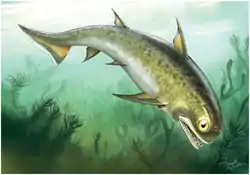Nerepisacanthus
Nerepisacanthus is an extinct genus of acanthodian, probably acritolepid, from Middle Silurian (?late Llandovery (Telychian) to Ludlow stages) deposits of New Brunswick, Canada. Nerepisacanthus is known from many incomplete but articulated specimens. It was collected from the Cunningham Creek Formation, near Nerepis, southern New Brunswick. It was first named by Carole J. Burrow in 2011 and the type species is Nerepisacanthus denisoni.[1] Additional specimen is known from Bertie Formation, making that species the oldest near-complete acanthodian.[2]
| Nerepisacanthus Temporal range: | |
|---|---|
 | |
| Illustration | |
| Scientific classification | |
| Domain: | Eukaryota |
| Kingdom: | Animalia |
| Phylum: | Chordata |
| Class: | †Acanthodii |
| Order: | †Ischnacanthiformes |
| Family: | †Acritolepidae |
| Genus: | †Nerepisacanthus Carole J. Burrow, 2011 |
| Species: | †N. denisoni |
| Binomial name | |
| †Nerepisacanthus denisoni Carole J. Burrow, 2011 | |
References
- Carole J. Burrow (2011). "A partial articulated acanthodian from the Silurian of New Brunswick, Canada". Canadian Journal of Earth Sciences. 48 (9): 1329–1341. Bibcode:2011CaJES..48.1329B. doi:10.1139/e11-023.
- Burrow, Carole J.; Rudkin, David (2014-08-05). "Oldest Near-Complete Acanthodian: The First Vertebrate from the Silurian Bertie Formation Konservat-Lagerstätte, Ontario". PLOS ONE. 9 (8): e104171. Bibcode:2014PLoSO...9j4171B. doi:10.1371/journal.pone.0104171. ISSN 1932-6203. PMC 4122448. PMID 25093877.
This article is issued from Wikipedia. The text is licensed under Creative Commons - Attribution - Sharealike. Additional terms may apply for the media files.